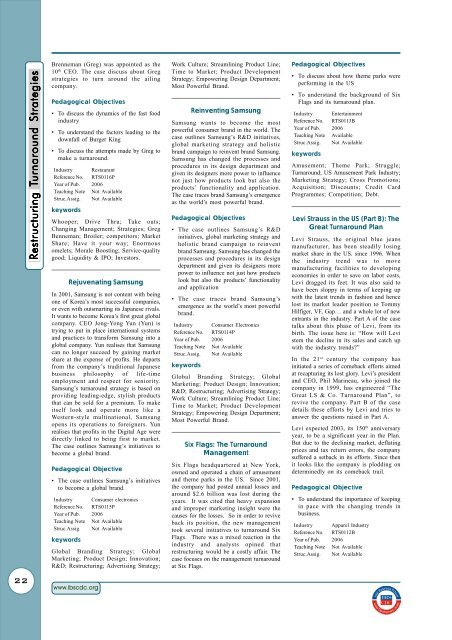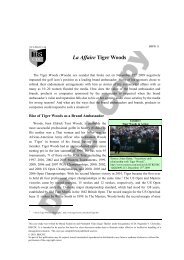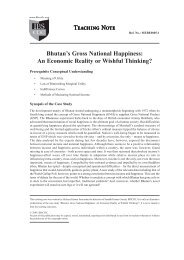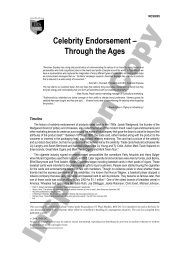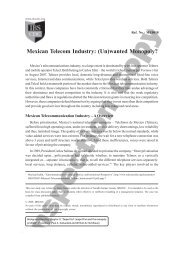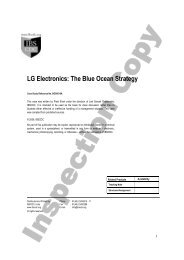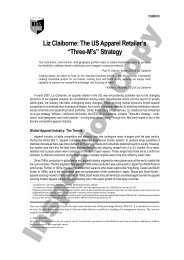List of Case Studies on Strategy - Case Catalogue IV
List of Case Studies on Strategy - Case Catalogue IV
List of Case Studies on Strategy - Case Catalogue IV
Create successful ePaper yourself
Turn your PDF publications into a flip-book with our unique Google optimized e-Paper software.
22<br />
Restructuring estructuring T TTurnaround<br />
T urnaround Strategies<br />
Strategies<br />
Brenneman (Greg) was appointed as the<br />
10 th CEO. The case discuss about Greg<br />
strategies to turn around the ailing<br />
company.<br />
Pedagogical Objectives<br />
• To discuss the dynamics <str<strong>on</strong>g>of</str<strong>on</strong>g> the fast food<br />
industry<br />
• To understand the factors leading to the<br />
downfall <str<strong>on</strong>g>of</str<strong>on</strong>g> Burger King<br />
• To discuss the attempts made by Greg to<br />
make a turnaround.<br />
Industry Restaurant<br />
Reference No. RTS0116P<br />
Year <str<strong>on</strong>g>of</str<strong>on</strong>g> Pub. 2006<br />
Teaching Note Not Available<br />
Struc.Assig. Not Available<br />
keywords<br />
Whooper; Drive Thru; Take outs;<br />
Changing Management; Strategies; Greg<br />
Benneman; Broiler; competitors; Market<br />
Share; Have it your way; Enormous<br />
omelets; Morale Boosting; Service-quality<br />
good; Liquidity & IPO; Investors.<br />
Rejuvenating Samsung<br />
In 2001, Samsung is not c<strong>on</strong>tent with being<br />
<strong>on</strong>e <str<strong>on</strong>g>of</str<strong>on</strong>g> Korea’s most successful companies,<br />
or even with outsmarting its Japanese rivals.<br />
It wants to become Korea’s first great global<br />
company. CEO J<strong>on</strong>g-Y<strong>on</strong>g Yun (Yun) is<br />
trying to put in place internati<strong>on</strong>al systems<br />
and practices to transform Samsung into a<br />
global company. Yun realises that Samsung<br />
can no l<strong>on</strong>ger succeed by gaining market<br />
share at the expense <str<strong>on</strong>g>of</str<strong>on</strong>g> pr<str<strong>on</strong>g>of</str<strong>on</strong>g>its. He departs<br />
from the company’s traditi<strong>on</strong>al Japanese<br />
business philosophy <str<strong>on</strong>g>of</str<strong>on</strong>g> life-time<br />
employment and respect for seniority.<br />
Samsung’s turnaround strategy is based <strong>on</strong><br />
providing leading-edge, stylish products<br />
that can be sold for a premium. To make<br />
itself look and operate more like a<br />
Western-style multinati<strong>on</strong>al, Samsung<br />
opens its operati<strong>on</strong>s to foreigners. Yun<br />
realises that pr<str<strong>on</strong>g>of</str<strong>on</strong>g>its in the Digital Age were<br />
directly linked to being first to market.<br />
The case outlines Samsung’s initiatives to<br />
become a global brand.<br />
Pedagogical Objective<br />
• The case outlines Samsung’s initiatives<br />
to become a global brand.<br />
Industry C<strong>on</strong>sumer electr<strong>on</strong>ics<br />
Reference No. RTS0115P<br />
Year <str<strong>on</strong>g>of</str<strong>on</strong>g> Pub. 2006<br />
Teaching Note Not Available<br />
Struc.Assig.<br />
keywords<br />
Not Available<br />
Global Branding <strong>Strategy</strong>; Global<br />
Marketing; Product Design; Innovati<strong>on</strong>;<br />
R&D; Restructuring; Advertising <strong>Strategy</strong>;<br />
www.ibscdc.org<br />
Work Culture; Streamlining Product Line;<br />
Time to Market; Product Development<br />
<strong>Strategy</strong>; Empowering Design Department;<br />
Most Powerful Brand.<br />
Reinventing Samsung<br />
Samsung wants to become the most<br />
powerful c<strong>on</strong>sumer brand in the world. The<br />
case outlines Samsung’s R&D initiatives,<br />
global marketing strategy and holistic<br />
brand campaign to reinvent brand Samsung.<br />
Samsung has changed the processes and<br />
procedures in its design department and<br />
given its designers more power to influence<br />
not just how products look but also the<br />
products’ functi<strong>on</strong>ality and applicati<strong>on</strong>.<br />
The case traces brand Samsung’s emergence<br />
as the world’s most powerful brand.<br />
Pedagogical Objectives<br />
• The case outlines Samsung’s R&D<br />
initiatives, global marketing strategy and<br />
holistic brand campaign to reinvent<br />
brand Samsung. Samsung has changed the<br />
processes and procedures in its design<br />
department and given its designers more<br />
power to influence not just how products<br />
look but also the products’ functi<strong>on</strong>ality<br />
and applicati<strong>on</strong><br />
• The case traces brand Samsung’s<br />
emergence as the world’s most powerful<br />
brand.<br />
Industry C<strong>on</strong>sumer Electr<strong>on</strong>ics<br />
Reference No. RTS0114P<br />
Year <str<strong>on</strong>g>of</str<strong>on</strong>g> Pub. 2006<br />
Teaching Note Not Available<br />
Struc.Assig. Not Available<br />
keywords<br />
Global Branding <strong>Strategy</strong>; Global<br />
Marketing; Product Design; Innovati<strong>on</strong>;<br />
R&D; Restructuring; Advertising <strong>Strategy</strong>;<br />
Work Culture; Streamlining Product Line;<br />
Time to Market; Product Development<br />
<strong>Strategy</strong>; Empowering Design Department;<br />
Most Powerful Brand.<br />
Six Flags: The Turnaround<br />
Management<br />
Six Flags headquartered at New York,<br />
owned and operated a chain <str<strong>on</strong>g>of</str<strong>on</strong>g> amusement<br />
and theme parks in the US. Since 2001,<br />
the company had posted annual losses and<br />
around $2.6 billi<strong>on</strong> was lost during the<br />
years. It was cited that heavy expansi<strong>on</strong><br />
and improper marketing insight were the<br />
causes for the losses. So in order to revive<br />
back its positi<strong>on</strong>, the new management<br />
took several initiatives to turnaround Six<br />
Flags. There was a mixed reacti<strong>on</strong> in the<br />
industry and analysts opined that<br />
restructuring would be a costly affair. The<br />
case focuses <strong>on</strong> the management turnaround<br />
at Six Flags.<br />
Pedagogical Objectives<br />
• To discuss about how theme parks were<br />
performing in the US<br />
• To understand the background <str<strong>on</strong>g>of</str<strong>on</strong>g> Six<br />
Flags and its turnaround plan.<br />
Industry Entertainment<br />
Reference No. RTS0113B<br />
Year <str<strong>on</strong>g>of</str<strong>on</strong>g> Pub. 2006<br />
Teaching Note Available<br />
Struc.Assig. Not Available<br />
keywords<br />
Amusement; Theme Park; Struggle;<br />
Turnaround; US Amusement Park Industry;<br />
Marketing <strong>Strategy</strong>; Cross Promoti<strong>on</strong>s;<br />
Acquisiti<strong>on</strong>; Discounts; Credit Card<br />
Programmes; Competiti<strong>on</strong>; Debt.<br />
Levi Strauss in the US (Part B): The<br />
Great Turnaround Plan<br />
Levi Strauss, the original blue jeans<br />
manufacturer, has been steadily losing<br />
market share in the US. since 1996. When<br />
the industry trend was to move<br />
manufacturing facilities to developing<br />
ec<strong>on</strong>omies in order to save <strong>on</strong> labor costs,<br />
Levi dragged its feet. It was also said to<br />
have been sloppy in terms <str<strong>on</strong>g>of</str<strong>on</strong>g> keeping up<br />
with the latest trends in fashi<strong>on</strong> and hence<br />
lost its market leader positi<strong>on</strong> to Tommy<br />
Hilfiger, VF, Gap… and a whole lot <str<strong>on</strong>g>of</str<strong>on</strong>g> new<br />
entrants in the industry. Part A <str<strong>on</strong>g>of</str<strong>on</strong>g> the case<br />
talks about this phase <str<strong>on</strong>g>of</str<strong>on</strong>g> Levi, from its<br />
birth. The issue here is: “How will Levi<br />
stem the decline in its sales and catch up<br />
with the industry trends?”<br />
In the 21st century the company has<br />
initiated a series <str<strong>on</strong>g>of</str<strong>on</strong>g> comeback efforts aimed<br />
at recapturing its lost glory. Levi’s president<br />
and CEO, Phil Marineau, who joined the<br />
company in 1999, has engineered “The<br />
Great LS & Co. Turnaround Plan”, to<br />
revive the company. Part B <str<strong>on</strong>g>of</str<strong>on</strong>g> the case<br />
details these efforts by Levi and tries to<br />
answer the questi<strong>on</strong>s raised in Part A.<br />
Levi expected 2003, its 150th anniversary<br />
year, to be a significant year in the Plan.<br />
But due to the declining market, deflating<br />
prices and tax return errors, the company<br />
suffered a setback in its efforts. Since then<br />
it looks like the company is plodding <strong>on</strong><br />
determinedly <strong>on</strong> its comeback trail.<br />
Pedagogical Objective<br />
• To understand the importance <str<strong>on</strong>g>of</str<strong>on</strong>g> keeping<br />
in pace with the changing trends in<br />
business.<br />
Industry Apparel Industry<br />
Reference No. RTS0112B<br />
Year <str<strong>on</strong>g>of</str<strong>on</strong>g> Pub. 2006<br />
Teaching Note Not Available<br />
Struc.Assig. Not Available


